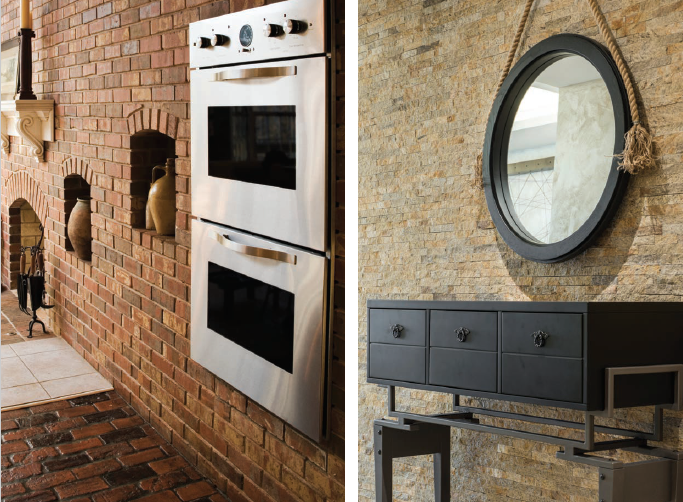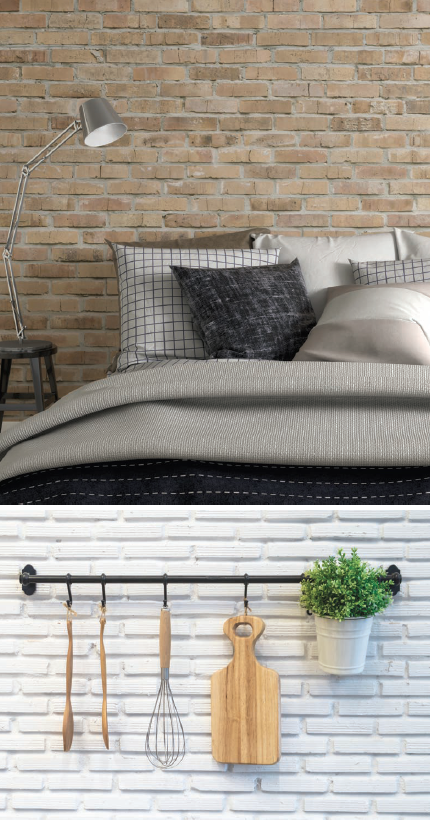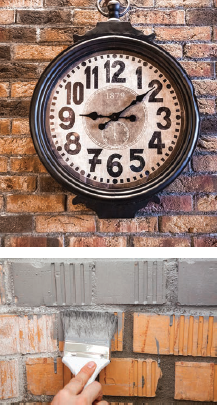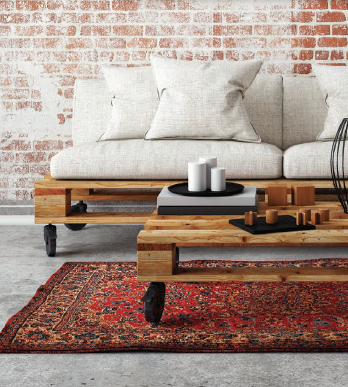Show It Off | How to Make Exposed Brick Walls Work for You


When my husband and I first saw the house we now live in, we were thrilled that it not only met the criteria for what we needed (a larger kitchen, room for a baby grand piano, a nice yard for our boys) and what we wanted (a screened-in porch), but that it came with a bonus: a room with an exposed brick wall. We wanted a home with character, and an exposed brick wall is made-from-scratch icing on the cake. Since no two brick walls are the same, exposed brick provides a room with plenty of personality, style and charm.
 Unlike some other hard materials (such as concrete), exposed brick can bring a sense of warmth and history to a room. You’ll find exposed brick in historic homes, especially properties from the turn of the last century; back then, leaving bricks exposed in the interior was a way to save money on finishing the walls. Other places that exposed brick walls turn up include ranch homes from the 1960s and 70s as well as loft-style apartments and condominiums. In addition, any modern home that has a brick exterior may also have some of that same exposed brick on the inside, if the owners have purposely left the brick exposed or if they have added a room along the line.
Unlike some other hard materials (such as concrete), exposed brick can bring a sense of warmth and history to a room. You’ll find exposed brick in historic homes, especially properties from the turn of the last century; back then, leaving bricks exposed in the interior was a way to save money on finishing the walls. Other places that exposed brick walls turn up include ranch homes from the 1960s and 70s as well as loft-style apartments and condominiums. In addition, any modern home that has a brick exterior may also have some of that same exposed brick on the inside, if the owners have purposely left the brick exposed or if they have added a room along the line.
If you want to include some exposed brick in your home, don’t worry, you don’t have to sell your house for this to happen! You have options. If you already have a brick exterior and you were planning to add a room on, simply add on and leave one wall all brick. Foregoing the full-on add-on route, you (or your licensed contractor) can simply expose the brick from behind the plaster walls or the drywall. Bear in mind the age and condition of your home if you choose to do this since you might remove insulation or uncover lead paint, among other things. A licensed contractor with experience in rehabbing older properties would be a tremendous asset in this circumstance. You might prefer to avoid the kind of dusty mess that comes with exposing your brick and choose instead to have a brick and mortar wall installed with thin bricks, or even install more budget-friendly, DIY-friendly brick veneer.
An exposed brick wall can be a home’s personal little black dress that can be dressed up or down. It pairs well with every style of decor: rustic, modern, industrial, cottage, farmhouse, traditional, Victorian, eclectic—there’s no limit to how you can decorate with exposed brick. Whatever your preference, bear in mind that brick may indeed work well as a blank canvas, but that doesn’t necessarily make it a neutral backdrop. All brick contains color and texture, two design components that you need to consider when styling the space.
 The biggest choice you need to make is how you wish to feature the brick: should it be a standout showstopper, or should it play a quiet supporting role in your space? The answer will guide you to how to dress the other walls. For instance, you’ll help the brick blend in if you paint the non-brick walls in a color that closely matches the mortar (usually a shade of gray, taupe or cream). Likewise, a paint color that contrasts with the color of your brick will work wonders for highlighting your exposed brick. For instance, if you have an orange undertone in the brick, walls and furnishings in shades of blue will both balance and draw the eye in.
The biggest choice you need to make is how you wish to feature the brick: should it be a standout showstopper, or should it play a quiet supporting role in your space? The answer will guide you to how to dress the other walls. For instance, you’ll help the brick blend in if you paint the non-brick walls in a color that closely matches the mortar (usually a shade of gray, taupe or cream). Likewise, a paint color that contrasts with the color of your brick will work wonders for highlighting your exposed brick. For instance, if you have an orange undertone in the brick, walls and furnishings in shades of blue will both balance and draw the eye in.
Always consider the color of your brick in your furnishings, but also know that you have the option to change its color. Now, I’m not talking about painting your brick—brick is a porous material and removing paint from brick is an enormously difficult task. In other words, there’s no going back to the authentic color. Just like wood stain, brick stains specially formulated for application on brick surfaces are now on the market. This is the perfect solution for homeowners who like their brick well enough, but just wish it could be a different color or shade.
Whatever you choose, keep in mind that the brick already contributes color and texture, so keep your palette to a minimum. To balance brick’s roughness, use soft, smooth and inviting textures in your fabric choices for things like pillows, throws, rugs and draperies. Another way to strike a balance involves adding sconces, track lighting or recessed lighting above the brick; this provides light, warmth and shadows, their interplay creating visual softness.
 You can also create visual space in a brick-heavy room by hanging mirrors or art on the brick. It seems treacherous, but it’s not as treacherous as you might think. There are two tricks for hanging heavier items from brick walls successfully: be sure about the location of where you want to hang something since the hole will be permanent, and be sure to use a masonry drill bit and drill a hole directly into the mortar so you don’t damage the brick. Only drill deep enough to make room for the wall anchor in case there is any electrical wiring or plumbing behind the brick wall. Insert the wall anchor and screw a picture hook into the anchor (you can find special screws for this at your local hardware store). Make sure that the anchor and screw you use can adequately handle the weight of the object you are hanging! If this feels like a daunting task, you can always try brick clips that hook onto the brick. Again, check the weight limits of the clip against the item you wish to hang on it.
You can also create visual space in a brick-heavy room by hanging mirrors or art on the brick. It seems treacherous, but it’s not as treacherous as you might think. There are two tricks for hanging heavier items from brick walls successfully: be sure about the location of where you want to hang something since the hole will be permanent, and be sure to use a masonry drill bit and drill a hole directly into the mortar so you don’t damage the brick. Only drill deep enough to make room for the wall anchor in case there is any electrical wiring or plumbing behind the brick wall. Insert the wall anchor and screw a picture hook into the anchor (you can find special screws for this at your local hardware store). Make sure that the anchor and screw you use can adequately handle the weight of the object you are hanging! If this feels like a daunting task, you can always try brick clips that hook onto the brick. Again, check the weight limits of the clip against the item you wish to hang on it.
These days, my family spends the most time in that room with the “bonus” exposed brick wall, and it’s not a big surprise: we enjoy being together in warm, comfortable places, and brick lends this sense of cozy appeal to any space.
brick, diy, diy projects, exposed brick, home improvement, home projects, home restoration






